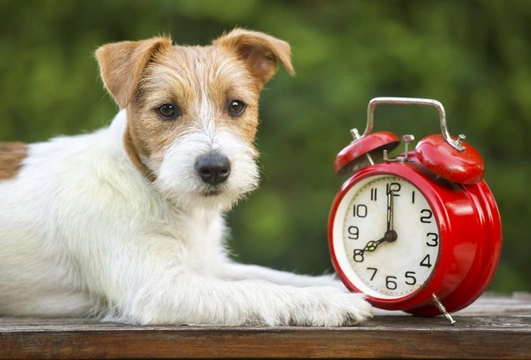
Managing your dog when the clocks go back
Here in the UK, we are more than used to the clocks changing twice a year to enable us to make the most of the daylight hours, and this means that in spring and autumn respectively, we either gain or lose an hour as we turn the clocks forwards or back in line with the rest of the country.
Whilst there is a reasonable amount of debate about whether changing the clocks is a good thing or if we would be better off maintaining our standard GMT clock throughout the year, most of us find ourselves a little out of whack for a few days after the clocks change either way, and it takes us some time to adjust.
Even though the difference is only one hour and the change happens during the night when most of us are asleep, when the clocks go back at the end of October, many of us will find ourselves thinking in “old time” and “new time” for a while, and feeling a little off kilter about the times that we get up and go to bed, and even have meals.
We humans understand what’s going on when we put the clocks back and still find it a little disconcerting – and so it is no wonder that this change can also be confusing for your dog, who has no frame of reference and won’t understand why overnight, their whole routine and body clocks are out of line with what everyone else is doing and what your dog expects.
If you own a dog, you should make some allowances for this and schedule the way that you care for your dog to make the adjustment easier, and in this article we will share some tips and advice on how to do just this.
Read on to learn more about how to manage your dog when the clocks go back.
Sleeping, getting up and toileting
During the autumn when the clocks go back rather than forwards, it is somewhat more challenging to make the jump of an hour in timings than it is in the spring. This is because the clocks going back means that the day after the change, when your dog gets up at what is for them their normal time – probably needing the toilet – their handlers will be an hour behind, and probably still in bed!
If your dog has a set routine and can hold their bladder for a certain period of time overnight and is used to doing this, it is not really reasonable to expect them to hold on for an additional hour all in one go.
Make sure you let your dog out to do their business at around the time your dog is used to, and over the course of a few days, gradually ease them into the new routine by starting to adjust their timings by an additional 10 minutes a day – so that they go to bed and get up and toilet a little later each day.
Because your dog’s bedtimes and meal times will be adjusting too, your dog should soon get up to speed. You can also help you dog to adjust to the new routine faster by ensuring that they are tired by the time you want them to sleep, so make an extra effort with those walks and play sessions.
Feeding
Dogs like to be fed at the same times each day, and again, suddenly delaying their meals for an hour each time from the get-go will be confusing and frustrating for your dog.
As is the case when you begin to adjust the times that your dog goes to bed, gets up and toilets in the morning, make the change gradually by adjusting your dog’s mealtimes by around 10 minutes a day, and they will get back up to speed within a week.
Walks
It is somewhat easier to adjust the times that you walk your dog at than it is to change their feeding times and toileting routine, but until your dog again gets used to the time changes, you might find that they are hard work and full of beans waiting for their walk in the hour preceding it!
Allow your dog into the garden to toilet if they need to, and to spend some time outside entertaining themselves before the correct time for their walk.
Medications and health conditions
If your dog is on medications for a health condition or if a health condition has any other implications for your dog’s routine – such as meaning that they need to be fed at exactly the same time each day – you should talk to your vet about how to manage the change.
Whilst many conditions and their medications have quite a lot of leeway in them in terms of the times that you can administer them, others – such as insulin-dependent diabetes – will have a negative impact on your dog if their feeding and medication times suddenly change by an hour.
Generally, your vet will guide you on making gradual changes such as you might be considering doing with your dog’s walking and feeding schedule, but in some cases they might recommend a different approach.
Never make changes to your dog’s medications or medication routine without the approval of your vet – so check with them before the clocks change to discuss your plans, just to be on the safe side.



